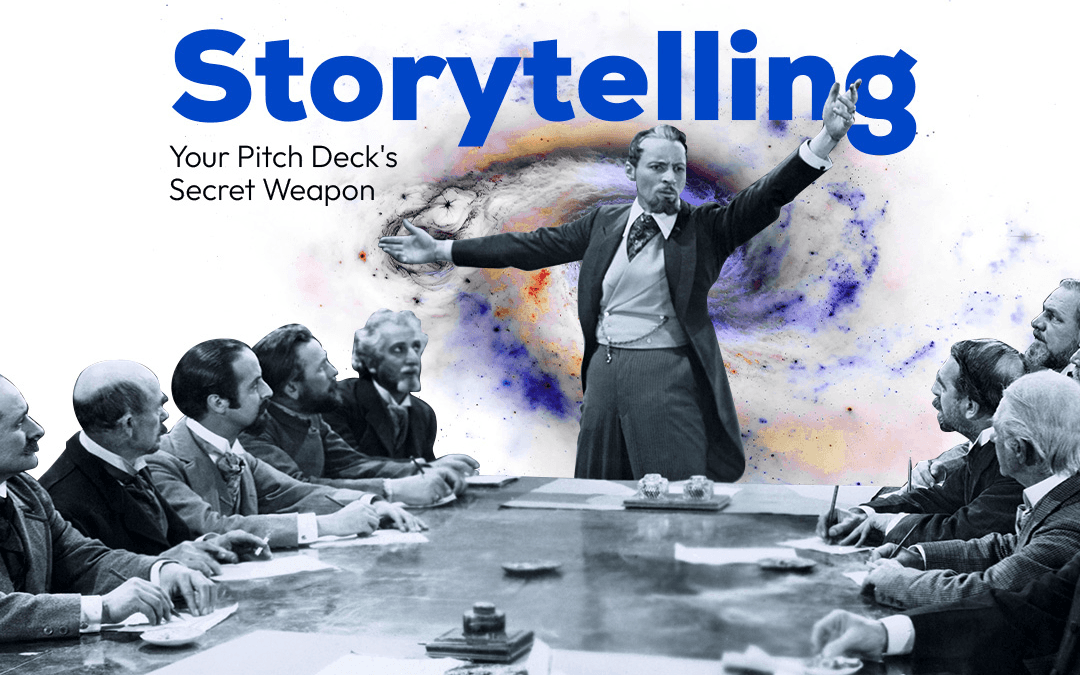Jun 4, 2024
In the competitive world of startups and investments, the ability to stand out is crucial. While a strong business plan and robust financial projections are essential, they often aren't enough to captivate investors. This is where storytelling comes in. Storytelling transforms a standard pitch deck into a compelling narrative that not only conveys information but also engages emotions and imagination.
The power of storytelling lies in its ability to create a connection between the presenter and the audience. It's a method that transcends mere data presentation, weaving facts into a narrative that resonates on a deeper level. When done effectively, storytelling can shape investor perceptions, making your pitch more memorable and persuasive.
In this article, we will delve into the psychology behind storytelling, explore the key elements of effective storytelling in pitch decks, examine strategic techniques, and review successful case studies. By the end, you'll have practical tips to incorporate storytelling into your own pitch decks, ensuring your presentations not only inform but also inspire. At Pitch Deck Edge, storytelling is of utmost importance. Stories can be said by words or just by visuals.
The Psychology of Storytelling
Humans are inherently drawn to stories. From ancient myths and legends to modern movies and books, storytelling is a fundamental part of our culture and communication. This deep-seated connection to stories is rooted in psychology, making storytelling a powerful tool in presentations, including pitch decks.
1. Emotional Engagement: Stories engage emotions, which is crucial for capturing and holding attention. When investors are emotionally engaged, they are more likely to be interested and invested in what you are saying. Emotional engagement helps in creating a memorable pitch that stands out among numerous others.
2. Cognitive Processing: Our brains are wired to process information more effectively when it is presented as a story. Stories help in organizing information in a way that is easier to understand and remember. This cognitive processing advantage means that investors are more likely to recall key points from your pitch deck when it is structured as a narrative.
3. Persuasion and Influence: Stories have the power to persuade by influencing attitudes and beliefs. A well-crafted story can change perceptions and inspire action. In the context of a pitch deck, storytelling can make your business proposition more compelling and convincing, leading investors to see the potential and value in your idea.
4. Relatability and Connection: Through stories, you can create a sense of relatability and connection. Investors need to relate to your vision and believe in your team’s capability to execute it. By sharing personal anecdotes, challenges, and successes, you humanize your pitch, making it more relatable and trustworthy.
5. Attention and Retention: In a world filled with information overload, capturing and maintaining attention is challenging. Stories cut through the noise by providing a cohesive and engaging narrative that keeps the audience interested. Additionally, because stories are easier to remember, your pitch is more likely to stick with investors long after the presentation is over.
Understanding the psychology behind storytelling highlights why it is such an effective tool in pitch decks. By tapping into emotions, enhancing cognitive processing, and fostering connection, storytelling significantly shapes investor perceptions and improves the likelihood of securing investment.
Strategic Use of Storytelling Techniques
Crafting a compelling pitch deck requires more than just telling a good story. It involves strategically using storytelling techniques to enhance the narrative and effectively communicate your message. Here are some key strategies to elevate your pitch deck through storytelling:
1. Craft a Compelling Opening: The opening of your pitch deck sets the tone for the entire presentation. Start with a hook that grabs attention and piques interest. This could be a surprising fact, a powerful quote, or a short, impactful story that relates to your business. The goal is to immediately engage your audience and make them eager to hear more.
2. Use Data and Visuals to Support the Narrative: While stories engage emotions, data provides credibility. Combine storytelling with solid data to create a balanced and persuasive pitch. Use visuals like charts, graphs, and images to illustrate key points and make complex information more digestible. Visuals not only enhance understanding but also make your pitch more memorable.
3. Ensure Coherence and Logical Flow: A great story needs to flow logically from one point to the next. Organize your pitch deck in a way that each slide builds upon the previous one, creating a cohesive narrative. This logical progression helps investors follow your story effortlessly and understand the overall message without confusion.
4. Highlight Unique Value Propositions Through Anecdotes: Anecdotes are powerful tools to illustrate your unique value propositions. Share specific examples or customer success stories that demonstrate how your product or service solves real problems. These anecdotes make abstract concepts tangible and show the real-world impact of your business.
5. Create a Relatable Hero: Incorporate characters in your story to create relatability. The hero of your story could be your company, a customer, or even yourself. Highlight the challenges faced, the journey undertaken, and the ultimate triumph. This narrative arc resonates with investors, making your story more engaging and believable.
6. Address Potential Objections with Storytelling: Anticipate and address potential objections within your narrative. Use stories to demonstrate how you’ve overcome challenges or mitigated risks in the past. By proactively addressing concerns, you build trust and confidence among investors.
7. Craft a Strong Conclusion: End your pitch deck with a strong conclusion that reinforces the key message and leaves a lasting impression. Summarize the main points, restate the value proposition, and include a clear call to action. A memorable ending ensures that your pitch stays top-of-mind for investors.
By strategically using these storytelling techniques, you can transform your pitch deck into a powerful narrative that captivates investors and clearly communicates the value of your business.
Practical Tips for Incorporating Storytelling in Your Pitch Deck
Incorporating storytelling into your pitch deck can significantly enhance its effectiveness. Here are the top five practical tips to help you weave a compelling narrative into your presentation:
1. Identify Your Core Story: Begin by identifying the core story you want to tell. This story should encapsulate the essence of your business, your mission, and what sets you apart. Think about the journey that led to the creation of your product or service, the problems you’re solving, and the impact you aim to achieve.
2. Know Your Audience: Tailor your story to resonate with your audience. Understand what your investors care about, their pain points, and their motivations. Use this insight to craft a narrative that speaks directly to their interests and concerns.
3. Create a Narrative Arc: Structure your pitch deck with a clear narrative arc, including a beginning, middle, and end. Introduce the problem you’re addressing, explain your solution, and highlight the positive outcomes. This structure helps maintain a logical flow and keeps your audience engaged.
4. Use Personal Anecdotes: Incorporate personal anecdotes to humanize your story and make it more relatable. Share experiences from your journey as an entrepreneur, challenges your team has overcome, or testimonials from satisfied customers. Personal stories create an emotional connection and make your pitch more memorable.
5. Highlight Key Milestones: Illustrate your progress and achievements through storytelling. Highlight key milestones in your business journey, such as significant product developments, major partnerships, or impressive growth metrics. These stories demonstrate your capability and build credibility.
By following these top five practical tips, you can create a pitch deck that not only presents your business effectively but also tells a compelling story that engages and inspires investors.
Conclusion
In the world of investment pitches, the ability to tell a compelling story can make all the difference. Storytelling transforms your pitch deck from a collection of data and facts into a captivating narrative that resonates with investors on a deeper level. By engaging emotions, enhancing cognitive processing, and creating a relatable connection, storytelling significantly shapes investor perceptions.
Understanding the psychology behind storytelling and strategically incorporating storytelling techniques into your pitch deck are essential steps to stand out in the competitive investment landscape. Focus on identifying your core story, knowing your audience, creating a clear narrative arc, using personal anecdotes, and highlighting key milestones. These practical tips will help you craft a pitch that not only informs but also inspires confidence and enthusiasm in your audience.
Ultimately, storytelling is about making your vision and journey compelling and memorable. It’s about showing investors not just what your business is, but why it matters. By mastering the art of storytelling, you can transform your pitch decks into powerful tools that drive engagement, foster trust, and secure the investment you need to bring your vision to life.
Simon Mansell
Founder

Nathan Monty
Founder, Enamel Pure



